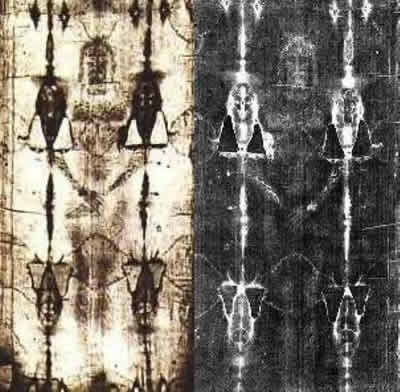
The Shroud of Turin (or Turin Shroud) is a linen cloth bearing the image of a man who appears to have been physically traumatized in a manner consistent with crucifixion. It is kept in the royal chapel of the Cathedral of Saint John the Baptist in Turin, Italy. It is believed by many to be a cloth worn by Jesus of Nazareth at the time of his burial, two days prior to his alleged resurrection.
The image on the shroud is much clearer in black-and-white negative than in its natural sepia color. The striking negative image was first observed on the evening of May 28, 1898 on the reverse photographic plate of amateur photographer Secondo Pia who was allowed to photograph it while it was being exhibited in the Turin Cathedral. According to Pia, he almost dropped and broke the photographic plate from the shock of seeing an image of a person on it.
The shroud is the subject of intense debate among some scientists, people of faith, historians, and writers regarding where, when, and how the shroud and its images were created. From a religious standpoint, in 1958 Pope Pius XII approved of the image in association with the Roman Catholic devotion to the Holy Face of Jesus, celebrated every year on Shrove Tuesday. Some believe the shroud is the cloth that covered Jesus when he was placed in his tomb and that his image was recorded on its fibers at or near the time of his alleged resurrection. Skeptics, on the other hand, contend the shroud is a medieval forgery; others attribute the forming of the image to chemical reactions or other natural processes.
Various tests have been performed on the shroud, yet the debates about its origin continue. Radiocarbon dating in 1988 by three independent teams of scientists yielded results published in Nature indicating that the shroud was made during the Middle Ages, approximately 1300 years after Jesus lived. Claims of bias and error in the testing were raised almost immediately, and were answered by Harry E. Gove ] and others. Yet the dating controversy has continued. Follow-up analysis published in 2005, for example, claimed that the sample dated by the teams was taken from an area of the shroud that was not a part of the original cloth. This analysis itself is questioned by skeptics such as Joe Nickell, who reason that the conclusions of the author, Raymond Rogers, result from "starting with the desired conclusion and working backward to the evidence". Former Nature or Philip Ball has said that the idea that Rogers steered his study to a preconceived conclusion is "unfair" and Rogers "has a history of respectable work".
To read complete article http://theunexplainedmysteries.com/turin-shroud.html

No comments:
Post a Comment